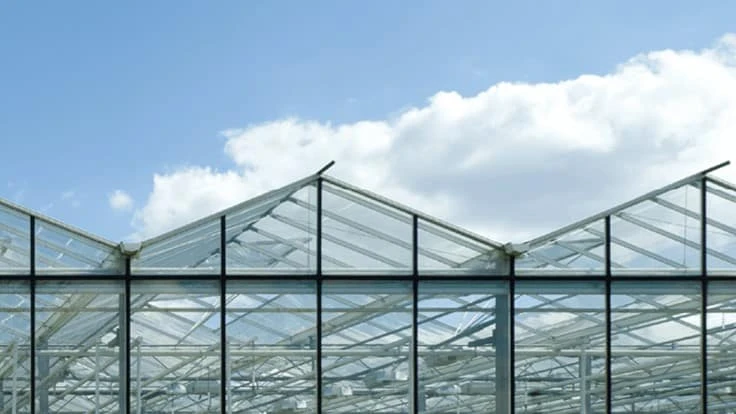

Greenhouses are controlled environments that have the potential to expand growth regions and seasons for food and flower production. Greenhouses can increase yield by an order of magnitude while reducing water and fertilizer consumption. However, the energy required to thermally regulate a greenhouse coupled with supplementary lighting makes greenhouses energy intensive, thereby hampering greenhouses from becoming environmentally sustainable.
Since the beginning of 2017, engineering, plant biology and physics researchers at North Carolina State University have been looking at ways to make greenhouses energy neutral using semi-transparent organic solar cells to harvest energy. These solar cells have the potential to compliment plant’s absorption spectra while generating power, thereby aiding plant growth while at the same time offsetting greenhouse energy demand. In this process, no additional land usage is required given that the solar cells can be integrated onto the greenhouse envelope.
Study intro
A systematic study focused on assessing greenhouse energy demand, synthesis of new materials to tune solar absorption spectra and the impact of different materials on plant growth. The feasibility of achieving energy neutral greenhouses is currently being evaluated.
These solar cells have the potential to compliment plant’s absorption spectra while generating power, thereby aiding plant growth while at the same time offsetting greenhouse energy demand.
Last year, Dr. Brendan O’Connor’s research group in Mechanical Engineering in collaboration with Dr. Heike Sederoff in Plant and Microbial Biology, Dr. Harald Ade in the Department of Physics and Dr. Carole Saravitz, Director at the Phytotron research facility developed an energy model to assess the ability of organic solar cells to meet the energy needs of greenhouses in climates across the US. It was found that energy neutral greenhouses can be achieved in warm and moderate climates. This was published in the study “Achieving Net Zero Energy Greenhouses by Integrating Semitransparent Organic Solar Cells”.
However, this came at the cost of losing nearly 30 percent of light in the Photosynthetically Active Radiation (PAR), in comparison to the reference greenhouse during winter. Hence, there was a need to ensure impact on crop yield is minimized. Now it has been demonstrated that it is possible to use semi-transparent organic solar cells that spectrally transmit and absorb light at various wavelengths to allow plant growth without any loss in yield. Their study was published recently in Cell Reports Physical Science.

Study methodology
To analyze crop yield, the researchers grew red leaf lettuce in a controlled environment growth chamber in the NC State Phytotron for 35 days, from germination to harvest. The chamber was equipped with ceramic metal halide and incandescent lights capable of providing a full spectrum of white light that comes closest to sunlight. Lettuce was selected because it forms an important greenhouse crop. It is also suitable for multiple replications in a reasonably short period and compact in size thereby allowing for the growth of these plants in the controlled environment growth chamber. All parameters, from temperature and water to fertilizer and CO2 concentration except for light, were controlled.
A control group of lettuces was exposed directly to the light source in the chamber, while the rest of the lettuces were divided into three experimental groups. Each of these groups was exposed to light through different types of filters that absorbed wavelengths of light equivalent to those that different types of semi-transparent solar cells would absorb. While the total light on the filters were maintained from one experimental group to the other, differences in filter transmittance meant plants experienced reductions in incident light by as much as 50 percent with respect to the control lettuce. Apart from changes in light intensity, the plants also experienced differences in ratio of blue to red light under the filters.

Study results
The researchers assessed various plant growth metrics like weight, leaf number, size and nutrient content. The amount of CO2 assimilation and chlorophyll content of the plants were also measured.
Promisingly, the researchers did not find any significant reduction in the yield and nutrient content of lettuce between the different filters and with respect to the control. Furthermore, a semi-transparent organic solar cell system design that absorbs light in a wavelength region highly complementary to the plant’s absorption spectra while also removing unwanted heat in the infrared wavelengths was demonstrated. The ability to tune absorption characteristics holds great promise to apply these cells in greenhouse that grow high light crops like tomato while also simultaneously aiding temperature control during hot summer months. Now there is a clear path to achieving a higher profit in the long term once growers can look past the initial investment in organic solar power technology.
Currently, Dr. Sederoff’s research group are now leading efforts to delve deeper and understand the effect of various wavelengths of light on the growth of not just lettuce but also tomatoes and other crops, such as greenhouse ornamentals A transcriptome analysis is currently being carried out that indicates certain filters have interesting effects on some molecular pathways effecting nutrient use efficiency and pathogen resistance. These preliminary results suggest the semitransparent solar cells may offer additional benefits for all plants.

Explore the May 2021 Issue
Check out more from this issue and find your next story to read.
Latest from Greenhouse Management
- Anthura acquires Bromelia assets from Corn. Bak in Netherlands
- Top 10 stories for National Poinsettia Day
- Langendoen Mechanical hosts open house to showcase new greenhouse build
- Conor Foy joins EHR's national sales team
- Pantone announces its 2026 Color of the Year
- Syngenta granted federal registration for Trefinti nematicide/fungicide in ornamental market
- A legacy of influence
- HILA 2025 video highlights: John Gaydos of Proven Winners





